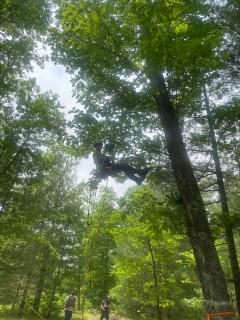Oak wilt suppression technique showing promise combating disease
WISCONSIN—A promising new technique developed by foresters at Menominee Tribal Enterprises to stop the spread of oak wilt is being tested by the USDA Forest Service and collaborators in the Midwest.
Oak wilt affects red and white oak and is the deadliest red oak disease in the eastern United States, killing every red oak it infects. The non-native disease kills hundreds of thousands of oak trees in forests, woodlots and home landscapes each year. Because it rapidly kills mature, otherwise healthy red oaks, oak wilt can quickly devastate this important resource.
The disease spreads naturally through oak forests in two ways: underground through the root systems, and above ground through infections caused by the movement of fungal spores by beetles in the family Nitidulidae, commonly called sap or picnic beetles, which are attracted to fresh wounds on oak trees.
Oak wilt also spreads through the movement of firewood and is a significant forest health concern in the upper Midwest. In Minnesota, it has been spreading slowly northward since the 1940s and has wreaked devastation—currently covering close to 40% of the state’s red oak group range. Its northward progression stops around Brainerd, about 120 miles south of Superior National Forest, closer to Chippewa National Forest.
Once infected, the only traditional way to stop the spread of oak wilt from tree-to-tree underground is to disrupt underground root grafting using expensive, heavy equipment.
Now a less expensive means has been tested and is showing promise.
James Jacobs is the forest health group leader in the St. Paul Field Office for Eastern Region Forest Health Protection working out of Minnesota. He said aside from disrupting connected oak root systems, the gradual spread of oak wilt underground may be stopped in its tracks before it moves underground by girdling a single infected tree, a technique developed by Menominee Tribal Enterprises. Girdling cuts off circulation between the upper parts of the tree and the root systems underground.
A study group formed in 2022 including the departments of Natural Resources of Minnesota, Wisconsin, and Michigan; the University of Minnesota; Michigan State University and Eastern Region Forest Health Protection. The group started collaborating to address the deadly spread of oak wilt by formally testing the single tree treatment technique developed at Menominee Tribal Enterprises. To do this, they first had to find enough trees to adequately test the technique.
They first tried to use a natural process for infecting an oak tree, but that proved unsuccessful. The group met and decided to try an artificial inoculation technique—infecting a single oak tree using tree climbers, drills and the fungus that causes oak wilt.
The tree climbers would climb 30-40 feet into the tree canopy, drill a hole in the tree, and then squirt a solution containing the fungus into the hole to start the infection. About 12 Forest Service Eastern Region tree climbers climbed and injected 20 targeted trees per state on Department of Natural Resources lands in Michigan, Wisconsin and Minnesota over the course of three weeks in June 2023.
The technique proved to be much more effective in infecting the tree without otherwise harming it and served to mimic the natural process in which sap beetles infect oaks through broken branches and other wounds. Symptoms of oak wilt in red oaks can be quite striking and are an early indicator of a successful infection.
Now they need to find more oaks showing signs of oak wilt infection and start girdling trees by removing bark from a ring around the tree’s trunk. Girdling has shown in recent testing to be an effective means in stopping the spread of oak wilt into the tree’s roots and, in turn, into adjacent oak trees.
The Menominee Tribal Enterprises and the Stockbridge-Munsee Band of Mohican Indians have for years been identifying oak trees in the area that show signs of aboveground spread of the disease and applying the single tree treatment where appropriate. However, to date, no formal study has been conducted to verify its effectiveness.
“We’re setting up a formal, systematic test. The last treatments should be next year for inoculating trees, if needed. The final girdle treatments will occur in the fall of 2024. And then the final year of monitoring in 2029. Each study site has treatment trees surrounded by red oak. We were relatively certain that the fungus would spread underground under these conditions,” Jacobs said. “This type of treatment to control oak wilt has never been published and we’re hoping to verify its effectiveness. If successful it would be a valuable new tool to reduce the damage caused by this disease across all ownerships of forests.”
The project is partially funded through a Forest Service Special Technology Development Program grant. Participating agencies, organizations and tribes are also contributing to the project through funding and in-kind services.
Jacobs said the group will continue to monitor treatment sites for the next five years. They have added this technique to the federal oak wilt suppression program and hope to publish the results of this study in time to a wider audience.




